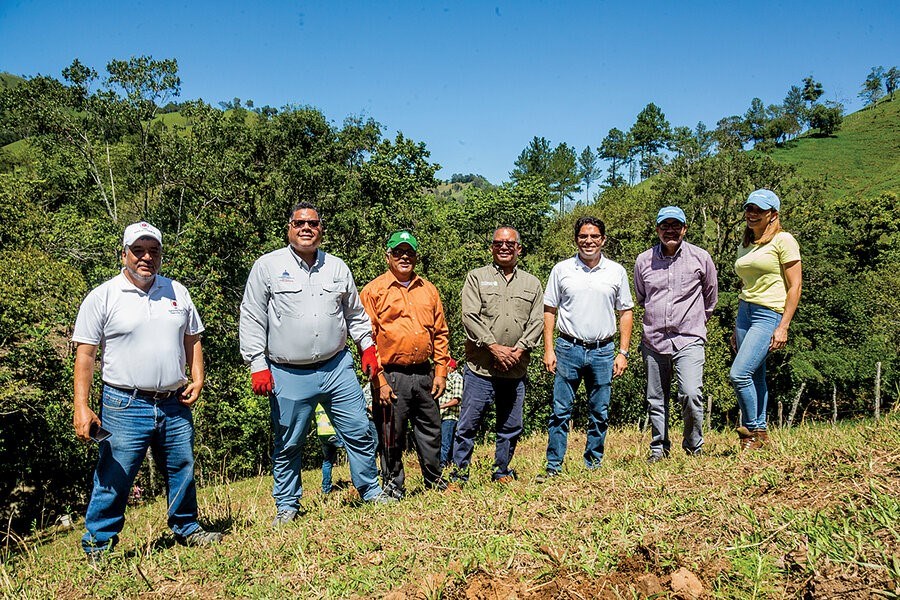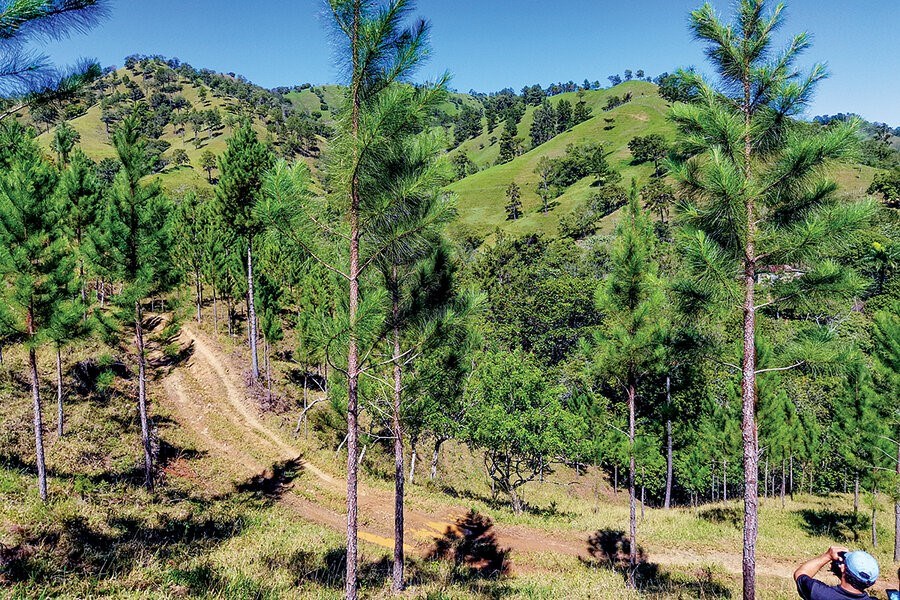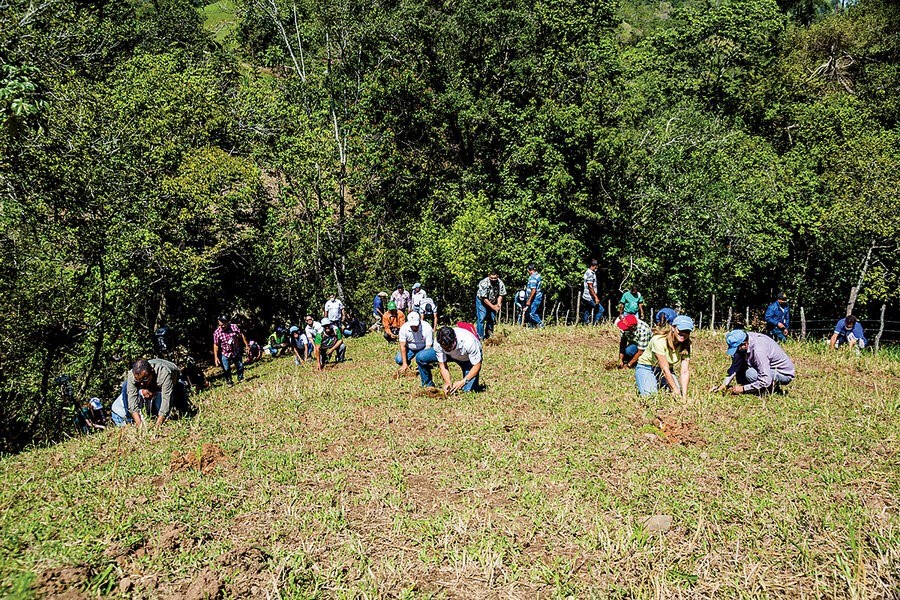Water scarcity is a problem that can seem too big to tackle. A collaboration among conservationists, the government, and businesses is making progress in the Dominican Republic.
 Francisco Núñez (center) stands with landowners and stakeholders of the Santo Domingo Water Fund in the Yaque del Norte watershed of the Dominican Republic, May 2023. Photo courtesy of The Nature Conservancy
Francisco Núñez (center) stands with landowners and stakeholders of the Santo Domingo Water Fund in the Yaque del Norte watershed of the Dominican Republic, May 2023. Photo courtesy of The Nature Conservancy
August 7, 2023|SANTO DOMINGO, DOMINICAN REPUBLIC- It wasn’t long ago that conservationist Francisco Núñez would set out by mule on one of his weekslong treks into the mountainous region known as the “Mother of the Water,” kicking up dust from the parched land underfoot.
Over the past 100 years, the land was stripped of trees for ranching and has deteriorated amid natural disasters and soaring demand for water in the Dominican Republic’s cities. As a result, the nation’s four watersheds have been under severe strain, setting off extreme drought in 2015.
Mr. Núñez’s treks look vastly different from a decade ago, despite ongoing water scarcity, thanks to his dedication to recuperating the watersheds. The brown dirt has slowly been replaced by green grass, and Mr. Núñez now ducks under branches as he weaves in and out of the lush tree coverage planted to protect coffee and cacao crops across the mountainsides.
This project, part of a broader initiative known as the Latin America Water Funds Partnership, which has created 24 water funds across the region, was successful in part because it involved an array of interests, from the private sector to government officials to local farmers.
Communities are paid to plant trees, which help prevent soil erosion, enabling the ground to retain its water and revitalize watersheds. Between 2011 and 2023, nearly 5,000 acres of water-producing ecosystems located in the Dominican Republic’s mountains have been restored, connecting hundreds of families with clean water.
“There’s an understanding now that to fix the water crisis, we need to rebuild the watersheds,” says Mr. Núñez. “This model is about everybody coming together ... to work together with the same goal,” he says.
 Photo courtesy of The Nature ConservancyA lush, healthy landscape is seen in the Yaque del Norte watershed.
Photo courtesy of The Nature ConservancyA lush, healthy landscape is seen in the Yaque del Norte watershed.
From frogs to forest
In many ways, Mr. Núñez was born to be a conservationist. His mother, Ana Mercedes Henriquez, was a pioneering environmentalist here. As a boy, Mr. Núñez helped care for the amphibians she’d bring home for research, and he’d tag along on trips into the field, where his passion for the environment, hikes, and the mountains grew.
“I was her personal assistant from age 12,” he says with a laugh. “I even received a little salary for taking care of the frogs.”
After completing undergraduate studies in the Dominican Republic, he went on to the United States on a Fulbright scholarship, where he focused on animal behavior, evolution, and ecology in New York. But he couldn’t stop thinking about the environmental challenges unfolding back home, where ranches, agriculture, and development were putting extreme pressures on the country’s infrastructure and natural resources.
“I realized I needed to pay attention to conservation of my home country’s biodiversity,” he says. “There was a need to go beyond just scientific studies.” He returned home, and since 1999, he’s served as the Greater Antilles program director for The Nature Conservancy, an international nonprofit.
“Our country is in severe drought,” Mr. Núñez says, noting that some residents of the capital have gone without water for more than three weeks at a time. “There’s been almost a century of overusing our natural resources.” But in recent years, “the government and the people are understanding that water is a major issue” that needs to be addressed, he says.
Water supply isn’t exactly the problem; it’s the degradation of the forest cover in the mountains, as well as high consumption, that’s making the resource scarce. There’s plenty of rain in the mountains, but it needs to be retained in the ecosystem when it falls and then managed farther downstream, Mr. Núñez says.
He helped develop the Latin America Water Funds Partnership, which works across the region to tackle water insecurity. The Nature Conservancy is one of the fund’s partners, alongside the Inter-American Development Bank and a handful of regional conservation nonprofits. Funding for the Santo Domingo and Yaque del Norte water funds in the Dominican Republic comes from 30 private companies and foundations, including The Coca-Cola Co. Perhaps most importantly, the project works with over 300 local families.
At first, persuading communities to support the initiative was a challenge. There was little trust in outside programs and not much understanding of how forests could reduce soil erosion and aid the health of rivers and crops. It took months, he says, to persuade the initial farmers to sign up, visiting small creeks and pointing out where different tree species could help restore the waterways. “We convinced a couple of farmers,” Mr. Núñez remembers, “and once everybody saw how well this was working, they started lining up to be a part.”
 Photo courtesy of The Nature ConservancyLocals and stakeholders of the Santo Domingo Water Fund plant saplings in the Yaque del Norte watershed.
Photo courtesy of The Nature ConservancyLocals and stakeholders of the Santo Domingo Water Fund plant saplings in the Yaque del Norte watershed.
Water and economy
Local farmers are compensated for planting trees on their farmland. Mr. Núñez’s team provides seeds and fertilizers, as well as training in best agricultural practices. There are additional payments made to participants for tree upkeep, including cleaning around the roots and applying fertilizer if needed. The farmers are also earning money from the sale of the crops. Mr. Núñez and his team return every few months – and still check in on communities that have been working with them for the past decade.
Esteban Polanco, who heads a farmers association working to combat drought and heal the degraded landscape, describes the project as solving a “fundamental” issue in the community. Mr. Núñez and his team have helped build infrastructure to hold returning water, including pipes, small aqueducts, and water tanks.
It “brings relief to the great needs of the community,” Mr. Polanco says. Today, there are more people waiting to join the efforts than Mr. Núñez can accommodate. “When you see your neighbor is benefiting from something, you want to benefit, too.”
To date, no farmers have pulled out of the program. “For local agricultural families it creates an influx of jobs and economic opportunities,” adds Mr. Polanco.
The Dominican Republic’s water funds are some of the “best examples” of collaborative environmentalism in Latin America, says Milagros de Camps, deputy minister of international cooperation in the Ministry of Environment. “It’s an example of where we can truly demonstrate that by bringing together the community with the public and private sectors, we can take more efficient steps to help tackle climate change.”
The legacy continues
Although Mr. Núñez has helped restore thousands of acres of degraded land, he sees his personal impact as small. Over the next decade he hopes to double the number of acres restored. And perhaps, he says, this work won’t stop with him.
His daughter is a biologist studying invasive species here – the family’s third generation to fight for the nation’s natural resources. Mr. Núñez’s wife is also a scientist, and as in his childhood, together they took their daughter on trips into the field when she was growing up.
It’s “not a coincidence,” he chuckles. “More than ever, this is the time that the planet needs more people dedicated to saving it.”
Related stories
Page created on 8/11/2023 9:25:45 AM
Last edited 8/11/2023 9:39:23 AM
